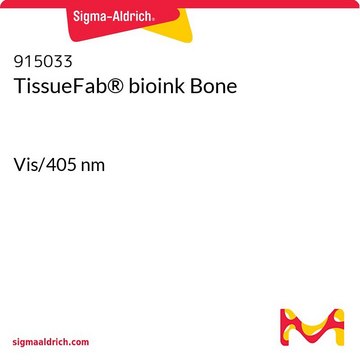915637
TissueFab® bioink Bone
support gel
Sinonimo/i:
3D Bioprinting, 3D printing, Bioink, TissueFab
Autenticatiper visualizzare i prezzi riservati alla tua organizzazione & contrattuali
About This Item
Codice UNSPSC:
12352201
NACRES:
NA.23
Prodotti consigliati
Descrizione
suitable for 3D bioprinting applications
Livello qualitativo
Forma fisica
powder
Colore
white
applicazioni
3D bioprinting
Cerchi prodotti simili? Visita Guida al confronto tra prodotti
Categorie correlate
Applicazioni
TissueFab® - Bone support bioink is suitable for printing bone scaffold or using as a supporting bioink for bone specific hydrogel/matrix bioink. It is formulated with optimal ratio of PCL and HAp, which shows excellent printability and osteogenic bioactivity. Polycaprolactone (PCL) is a synthetic biodegradable polymer that has been widely used as 3D printed bone scaffold material. Hydroxyapatite (HAp) has a chemical similarity with the mineralized phase of bone which accounts for their excellent biocompatibility and osteoinductive and osteoconductive properties favorable for bone regeneration.
Confezionamento
5g in glass bottle
Note legali
TISSUEFAB is a registered trademark of Merck KGaA, Darmstadt, Germany
Codice della classe di stoccaggio
11 - Combustible Solids
Classe di pericolosità dell'acqua (WGK)
WGK 3
Scegli una delle versioni più recenti:
Certificati d'analisi (COA)
Lot/Batch Number
Ci dispiace, ma al momento non ci sono COA disponibili online per questo prodotto.
Se ti serve aiuto, non esitare a contattarci Servizio Clienti
Possiedi già questo prodotto?
I documenti relativi ai prodotti acquistati recentemente sono disponibili nell’Archivio dei documenti.
Liang Dong et al.
Scientific reports, 7(1), 13412-13412 (2017-10-19)
Synthetic polymeric scaffolds are commonly used in bone tissue engineering (BTE) due to their biocompatibility and adequate mechanical properties. However, their hydrophobicity and the lack of specific cell recognition sites confined their practical application. In this study, to improve the
Boontharika Chuenjitkuntaworn et al.
Journal of biomedical materials research. Part A, 94(1), 241-251 (2010-02-19)
Polycaprolactone (PCL) is a synthetic biodegradable polymer that has been approved for use as bone graft substitutes. In this study, PCL scaffolds incorporating hydroxyapatite (HAp) particles were fabricated by combined solvent casting and particulate leaching techniques. The average pore dimension
Mitchell A Kuss et al.
RSC advances, 7(47), 29312-29320 (2017-07-04)
Reconstruction of complex, craniofacial bone defects often requires autogenous vascularized bone grafts, and still remains a challenge today. In order to address this issue, we isolated the stromal vascular fraction (SVF) from adipose tissues and maintained the phenotypes and the
Il team dei nostri ricercatori vanta grande esperienza in tutte le aree della ricerca quali Life Science, scienza dei materiali, sintesi chimica, cromatografia, discipline analitiche, ecc..
Contatta l'Assistenza Tecnica.







